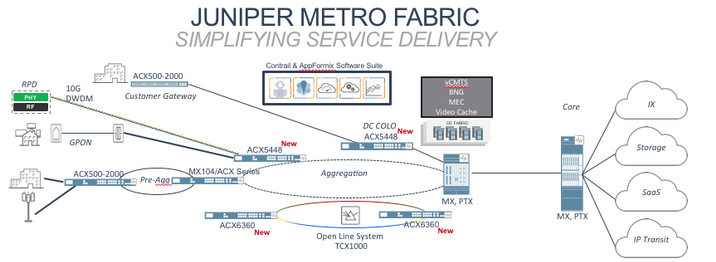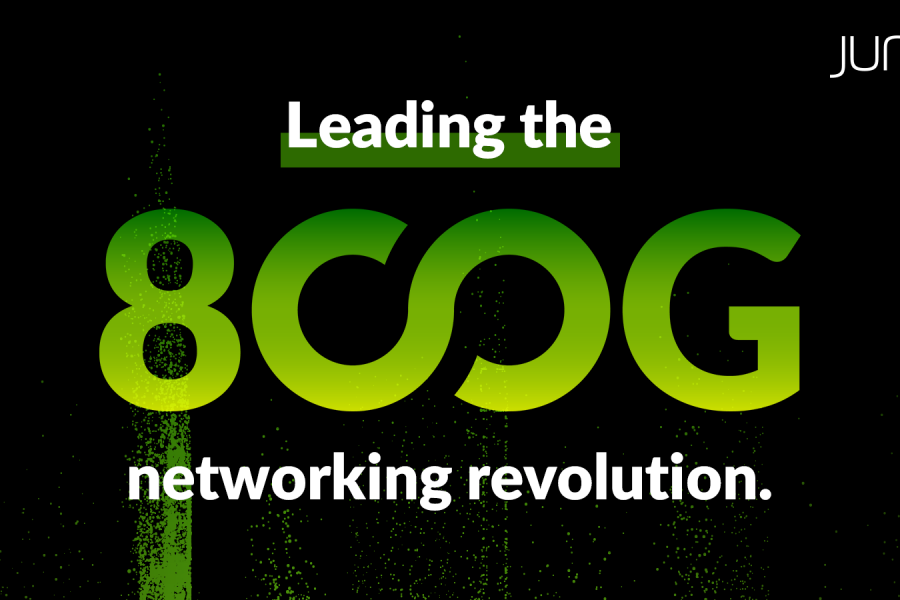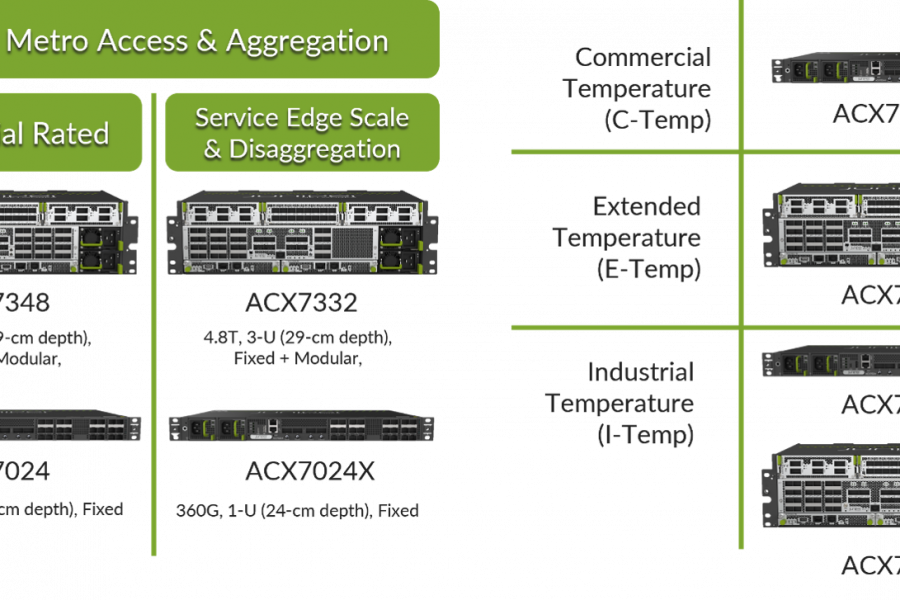Today Juniper Networks announced several innovations that will simplify service delivery in the metro for operators across cable, residential fiber, direct public cloud connectivity and various mobile backhaul services. Juniper’s Metro Fabric provides operators with an adaptive software layer and agile infrastructure that, when combined, create a holistic service-centric fabric that simplifies operations, mitigates infrastructure churn and continuously optimizes network economics.
This reimagining of the metro brings together both new and existing Juniper ACX Series, MX Series and PTX Series product lines with the only open and disaggregated optical line systems in the TCX1000 Programmable Photonic Layer to seamlessly merge rich packet capabilities with high capacity optical into a single, converged network experience.
Juniper’s Metro Fabric is designed for simplicity, with an adaptive software layer (the union of Juniper’s Contrail and AppFormix software suites), that works with an agile converged network infrastructure to eliminate the legacy operational ritual that has plagued the Metro since its inception.

Figure 1: Juniper’s Metro Fabric simplifies service delivery.
Here are five real-world use cases supported by Juniper’s new Metro Fabric
- Ethernet Business Services: Service providers are transitioning to 100GbE speeds to keep pace with the demand for business services, growing at double-digit rates, but they still need to lower the cost per bit while scaling bandwidth. In fact, 71% of service provider respondents in IHS 2018 Metro Optical Trends report ranked lower-cost optimized 100GbE hardware as the number one requirement for Metro applications[1]. Juniper’s Metro Fabric addresses Ethernet business service needs with a robust line-up of routers, including the new ACX5448 Universal Metro Router, built to smooth the transition from 10GbE to 100GbE for growing business, residential and cloud services delivery. The ACX5448 features 48 10GbE aggregation ports and four high-capacity 100GbE uplink ports, supporting full Metro Ethernet and IP/MPLS EVPN services in a space- and cost-optimized platform. Working with the ACX500, ACX1000 and ACX2000 Universal Metro Routers, operators also get robust OAM and SLA control capabilities combined with automation and zero-touch provisioning (ZTP) to ensure a seamless migration and simplified operations.
- Cable Distributed Access Architecture: An all IP-powered cable-distributed access architecture (DAA) now extends from the core into the access network. Therefore, operators need a cost-effective and dependable multi-gigabit access link to support growing commercial and residential customer needs. To advance this architecture, Juniper’s Metro Fabric introduces the new ACX6360 Universal Metro Router to bridge between a secure packet optical transport layer and IP/MPLS networking, letting operators collapse multiple layers in a single platform. With this approach, operators can now aggregate multiple 10Gbps into 200Gbps interfaces located within the cable head-end and optically transport them to remote field sites to support emerging remote physical and Ethernet physical access networks. IHS predicts that 100Gbps, 200Gbps and super-channel transport will represent a staggering 65% of all interface types in the Metro by 2019[2].
- Residential Fiber Services: For emerging scale-out architectures transitioning from 10GbE to 100GbE, Juniper’s Metro Fabric helps operators cost-effectively meet emerging 100GbE transport requirements in the metro area. The new ACX5448 supports emerging scale-out residential fiber-to-the home, curb, premise and building architectures by providing a flexible and cost-effective path for 10GbE to 100GbE aggregation.
- Internet Exchange Direct Cloud Connectivity: As more workloads move to the public cloud, internet exchange providers must provide high-capacity direct connectivity services to public cloud providers. Juniper’s Metro Fabric enables this transition with the new PTX10002 Packet Transport Router, providing the foundation for scale-out exchange and cloud architectures through high-capacity, cost-optimized 100GbE interfaces that enable providers to continuously improve cost-per-bit economics.
- Mobile Backhaul: Juniper’s Metro Fabric supports mobile backhaul applications by providing an adaptive software layer that simplifies capacity planning and introduces the ability to slice the network into completely isolated management, control and data plane domains, supported by the newly announced Contrail Network SlicingBot. Working in conjunction with this adaptive software layer, an agile infrastructure layer securely and reliably provides the performance and scale necessary to support future mobile traffic growth. In fact, it’s predicted in Ericsson 2017 Mobility Report[3] that mobility services will drive 71 ExaBytes of data across the metro by 2022, an 800% growth in traffic from 2016. This explosion of traffic is easily handled by Juniper’s Metro Fabric with an open, fully programmable optical layer powered by the TCX1000 and the new ACX6360. Complementing the packet-optical layer, the newly announced ACX5448 and the existing line of MX routers will include all the timing and IP/MPLS VPN required to deliver existing LTE-Advance Pro and emerging 5G services.Any Metro that requires manual intervention needs an overhaul. Juniper’s Metro Fabric redefines what a modern Metro network should be, imagining it as a platform that provides an extraordinary experience for operators and subscribers alike. Metro Fabric provides a platform that will predict trends and accommodate them seamlessly, a platform that introduces true business agility by continuously optimizing capital and operational resources, transforming the network into a competitive weapon that allows operators to differentiate themselves in the market. Adios to the past.
[1] 2018-IHSM-Metro-Optical-Trends-Report-Excerpts-for-Juniper
[2] 2018-IHSM-Metro-Optical-Trends-Report-Excerpts-for-Juniper
[3] Source: Ericsson Mobility Report, 2017, Strategic Analyst 2017


